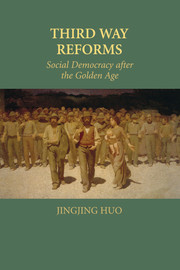Book contents
- Frontmatter
- Contents
- Tables and Figures
- Acknowledgments
- 1 Introduction
- 2 Theorizing the Third Way
- 3 Constraints on Action: Institutions and Ideas
- 4 Prelude to the Third Way: The Unemployment Problem and Earlier Responses
- 5 Expansion in Active Protection
- 6 Restructuring Passive Protection
- 7 Economic and Corporatist Contexts for the Third Way
- 8 Conclusion: Theories of Possibilities
- References
- Index
6 - Restructuring Passive Protection
Published online by Cambridge University Press: 20 February 2010
- Frontmatter
- Contents
- Tables and Figures
- Acknowledgments
- 1 Introduction
- 2 Theorizing the Third Way
- 3 Constraints on Action: Institutions and Ideas
- 4 Prelude to the Third Way: The Unemployment Problem and Earlier Responses
- 5 Expansion in Active Protection
- 6 Restructuring Passive Protection
- 7 Economic and Corporatist Contexts for the Third Way
- 8 Conclusion: Theories of Possibilities
- References
- Index
Summary
This chapter turns the focus from the active to the passive side of social protection. While active protection enhances the possibility of labor market integration, passive protection can potentially facilitate exclusion from the labor market. Compared with the active side, the partisan difference in passive protection reforms is noticeably smaller. The fundamental reason behind this narrower partisan difference is precisely the passive nature of these measures. On an ideological level, massive labor market exclusion goes against not only the third way principle of productivist solidarity and prioritarian egalitarianism but also the secular-right advocacy of social Darwinism through hard work and competition. On a policy level, low labor force participation was the key factor contributing to the fiscal crisis of social security across all welfare state types. Fiscal pressure on social security was especially serious where ideological sympathy for labor market detachment has traditionally been strong: Christian democratic welfare states. In short, no OECD government can afford not to make some changes to passive protection. The attempt to restructure, or worse, retrench, was almost universal across partisan colors.
Therefore, as evidence for power resources, partisan difference in passive protection was not nearly as drastic as in active protection. Having clarified this overall pattern, it is nevertheless still possible to notice some contrasts between social democracy and the center Right in how they approach passive social reforms. Again, while the center-right strategy is more or less divided between secular-right cost cutting and Christian democratic inaction, the social democratic strategy is action, but without exclusive emphasis on cost cutting.
Information
- Type
- Chapter
- Information
- Third Way ReformsSocial Democracy After the Golden Age, pp. 198 - 267Publisher: Cambridge University PressPrint publication year: 2009
